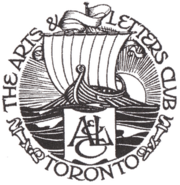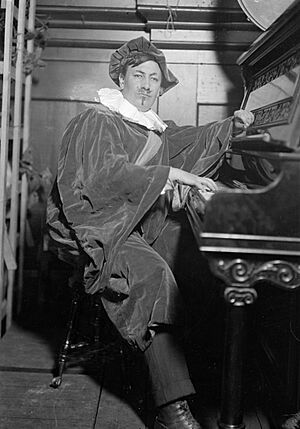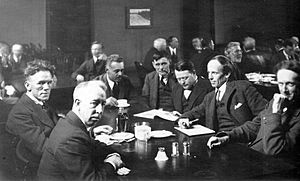Arts and Letters Club of Toronto facts for kids
 |
|
| Founded | 1908 |
|---|---|
| Type | Private members' club |
| Location |
|
| Website | artsandlettersclub.ca |
The Arts and Letters Club of Toronto is a special club in Toronto, Ontario, Canada. It's a place where people who love the arts and letters can meet. This includes writers, architects, musicians, painters, actors, and many others.
The club started in 1908. For a long time, it was only for men. But since 1985, women have also been able to join! It's a place for creative minds to connect and share ideas.
Contents
How the Club Started
Early Days and First Meetings
The Arts and Letters Club began in 1908. A journalist named Augustus Bridle organized the first meeting. People wanted a friendly place to meet and share their love for different types of art. They hoped to bring together people from various art fields. The club's first official meeting happened in late October 1908.
Moving to a Permanent Home
For a while, the club met in different places. In late 1909, they found their first home at 42 King St. East. Then, in 1910, they moved to 57 Adelaide St. East. Finally, in 1920, the club moved to its current location at 14 Elm Street. This building is called St. George's Hall. The club rented the building for many years. In 1986, they were able to buy it.
Welcoming Women Members
In 1985, the club made an important change: it started allowing women to become members. Forty-two women joined as "charter members" that year, including Laure Rièse.
St. George's Hall: The Club's Home
| St. George's Hall | |
|---|---|

Front of the building in 2007
|
|
| Location | 14 Elm Street Toronto, Ontario, Canada |
| Built | 1891 |
| Built for | St. George’s Society |
| Original use | Settlement house |
| Current use | Private club (since 1920) |
| Architect | Edwards & Webster (1891), Sproatt & Rolph (1920 alterations) |
| Owner | The Arts and Letters Club of Toronto |
| Designated | 2007 |
| Designated | 1975 |
The Arts and Letters Club is located in a very old and special building. It's called St. George's Hall and is at 14 Elm Street in downtown Toronto. This building is protected by law because of its history. The City of Toronto recognized it as a heritage site in 1975. Later, in 2007, it was named a National Historic Site of Canada. Sometimes, the building is open to the public during events like Doors Open Toronto.
Building Design and Features
St. George's Hall has a unique look. It mixes different building styles from the late 1800s. You can see parts of Romanesque, Flemish, and medieval architecture in its design. When the club moved in during 1920, they made many changes. They added new windows and a large stone fireplace in the main room, called the Great Hall.
Today, the building has several rooms for members. There's a lounge, meeting rooms, a library, and an art studio. The Great Hall is a large, two-story room. It's used for concerts, plays, talks, and meals.
Impact on Canadian Culture
The Arts and Letters Club has played a big role in Canadian culture. Many important people in arts organizations in Toronto were members of this club.
Meeting Place for Artists
In 1913, a famous writer named Rupert Brooke visited Toronto. He had lunch at the club. It was known as a central place for Canadian writers and artists. The artists who later formed the famous Group of Seven often met at the club.
Supporting Theatre and Art
Roy Mitchell, one of the club's founders, put on many plays there between 1911 and 1915. These plays introduced new ideas about theatre to Toronto audiences. In 1919, he worked with another member, Vincent Massey, to create the Hart House Theatre. Mitchell became its first artistic director.
In the 1920s, the club helped bring together Toronto's artists and thinkers. Journalists, poets, musicians, and artists like the Group of Seven enjoyed spending time there. In 1927, the club hosted the first solo show of abstract art in Canada by Bertram Brooker.
Shaping Arts Policy
In the 1940s, club members helped create the Canadian Arts Council. This group later became the Canadian Conference of the Arts in 1958. John Coulter started discussions at the club in 1943 about government support for the arts. In 1944, he and other members went to Ottawa to talk with government officials. As a result, the Canadian Arts Council was formed in 1945.
Later, in 1949, Vincent Massey led a special study called the Massey Commission. This led to the creation of the Canada Council in 1957. The Canada Council helps fund arts and culture across the country. Another club member, Claude Bissell, later became its second leader.
Theosophy Connection
In the club's early years, some members were interested in a philosophy called Theosophy. This included Albert E. S. Smythe, who was the first president of the Toronto Theosophical Society. Lawren Harris, a Group of Seven artist, also wrote about Theosophy and art. Roy Mitchell, who worked in theatre, also wrote books about Theosophy. His plays at the club often showed ideas from Theosophy. These early plays were fun and combined different art forms.
Connections to Theosophy continued with other members over the years. Artist Eric Aldwinckle was active in the Theosophical Society in the 1940s.
Notable Members
Many famous Canadians have been members of the Arts and Letters Club. Besides the Group of Seven artists, other well-known members include Robertson Davies, a famous writer, and Mavor Moore, a theatre director.
The club has had members who achieved great things. Two members, Frederick Banting and John Macleod, won the Nobel Prize. Banting was also a talented painter. Since 1967, more than 150 members have been named to the Order of Canada. This is one of Canada's highest honors. Some of these members include Betty Oliphant and Joyce Wieland.
Club Activities and Events
The club's activities are based on its "LAMPS" disciplines. These stand for Literature, Architecture, Music, Painting, and Stage. "Stage" includes all performing arts, and "Painting" includes photography. The club welcomes both professional artists and people who simply love and support the arts.
Regular Gatherings
The club offers many events. These include lunchtime talks and concerts. There are also dinners with speakers who talk about interesting topics. Members can enjoy film nights and stage performances. For artists, there are studio painting sessions three days a week. The club also holds art exhibitions for its members. There are groups for photography, writing, and poetry.
Special Traditions
One very old tradition is the annual Boar's Head Dinner. It's believed to be the oldest event of its kind in North America. The club also has a unique tradition for its yearly meeting. Its constitution, which is the club's rulebook, is sung to music specially written by Healey Willan.
Club Archives
The club keeps a large collection of old documents. These records show who its members were and what activities they did since the club started. These archives are open to students, historians, and other researchers. Thirty-four boxes of documents are stored at the Thomas Fisher Rare Book Library.
See also
- List of gentlemen's clubs in Canada







